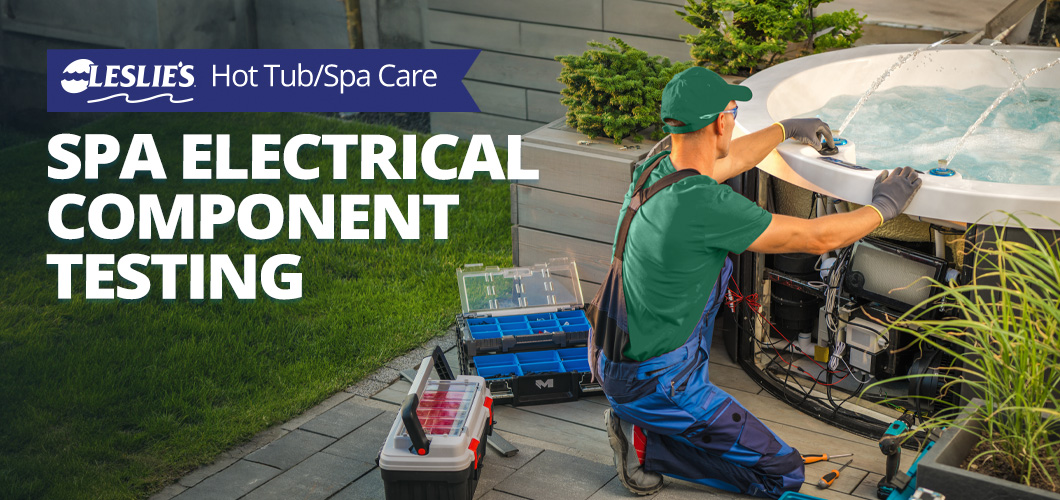
Spa Electrical Component Testing
Today's post is about testing spa and hot tub electrical component resistance, namely how to test for continuity on hot tub heater elements, fuses, transformers, sensors and switches. Testing electrical components can be hazardous, and should be performed by confident individuals aware of electrical hazards. For testing continuity or resistance, shut all power off to the spa, at the main breaker. Testing resistance when under power can damage your meter, the equipment tested, or yourself! Shut down all spa power disconnects.
To test a spa heater, transformer, sensors and switches, you will need a multi-meter that tests for Ohms Ω. You can find a digital multi-meter at any home or hardware store for under $15. Ohm meters will measure the known resistance in a spa electrical component, and can also be used to check for shorts in wires, cables and cords.
Testing Heater Elements
- Shut off all power to the spa at the breaker and spa pack
- Remove the wires or copper tabs on the heater element terminals
- Set your Ohm meter to the lowest setting
- Place your meter leads on the tip of each element terminal
- A reading of 10-14 Ohms is good for most heater elements
If your spa heater element (with wires or tabs removed) reads zero resistance, or displays 'Open', that means that the element sheath has a crack or the coil inside is otherwise grounding out, and should be causing your circuit breaker or GFCI to trip. Time for a new hot tub heater element or a complete spa heater assembly.
Testing Spa Transformers
- Shut off all power to the spa at the breaker and spa pack
- Set your Ohm meter to the lowest setting
- Locate the resistance values printed on the transformer
- Place your meter leads onto a Primary wire and a Secondary wire
- Compare the reading to the transformer specs specified
Transformers take 120V or 240V power and step it down to a reduced voltage to operate specific spa component circuits. Spa transformers that are soldered to the board are not as easy to test with an Ohm meter, and also keep in mind that many modern spas have several board mounted transformers.
Testing Spa Temperature Sensors
- Shut off all power to the spa at the breaker and spa pack
- Set your Ohm meter to the 20K setting
- Locate the wire ends and remove the plug from the board
- Place your meter leads onto the green and red wire
- Compare readings to Thermistor Resistance vs. Temperature Chart
Most spa and hot tub high limits, aka thermistors, thermal cut-offs and temperature sensors - will have a resistance reading of around 10000 at 77 degrees Fahrenheit. Colder water produces higher readings up to 50K, while warmer 100° F water will produce lower readings. Refer to your spa manufacturer resistance vs. temperature chart. Or, if you get "0", or a zero reading, the sensor or cable is likely bad. Many hot tubs have more than one temperature sensor; a heater sensor, water temp sensor and air temp sensor.
Testing Spa Fuses
- Shut off all power to the spa at the breaker and spa pack
- Set your Ohm meter to the 1K setting
- Remove the fuse from the board or fuse housing
- Place your meter leads on each end of the fuse
- Compare readings to printed Ohms level
Blown spa and hot tub fuses will not show any continuity, or a "0" reading when testing. Some meters will display "Open" or O.L. (for Open Loop). A clear fuse can also be visually inspected to see if the wire or coil inside is broken of course, but for opaque fuses, you can test them with your Ohm meter.
Testing Pressure Switch or Flow Switches
- Shut off all power to the spa at the breaker and spa pack
- Set your Ohm meter to the 1K setting
- Remove one wire from the pressure switch
- Place meter leads on both wire terminals
- If anything other than "0", adjust pressure switch
With one wire removed, the pressure switch, or flow switch, should have zero resistance, as the switch should be 'Open'. An Ohm meter can be used to adjust the pressure switch back to 'zero', by turning the adjustment knob or screw slightly until the meter drops to near zero.
In most spa components, resistance is good, with exception to pressure switches. No resistance is bad, as it means that there is another path that the electricity is taking, which usually means a defective component or cable, and it could also pose a safety hazard - where is the power loss going?
You can also use your multi-meter to test resistance of lengths of wire or cable. One probe on each end, and there should be resistance measured, NO resistance and there is a short somewhere.
Always remember, shut off power completely down when testing spa electrical components for resistance, in Ohms.